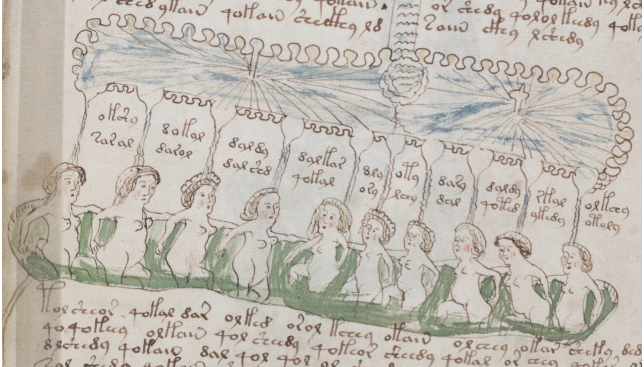
‘The language used was ubiquitous in the Mediterranean during the Medieval period, but it was seldom written in official or important documents because Latin was the language of royalty, church and government. It’s been described as the world’s most mysterious manuscript
#VOYNICH MANUSCRIPT MYSTERY CODE#
It is currently housed at Yale University, where it is filed as item MS408 in the Beinecke Library of rare books and manuscripts.Īmong those who have famously attempted to crack the code are Alan Turing and his colleagues at Bletchley Park. It is named after Wilfrid M Voynich, a Polish book dealer and antiquarian, who purchased the manuscript in 1912. NASA plan to put the first woman on the moon by 2024Ĭyclists ‘actually break traffic laws far less than drivers’Ĭommon painkiller ‘is actually just as addictive as opiates’ The Voynich manuscript is a medieval, handwritten and illustrated text, which has been carbon-dated to the mid-15th century. It’s been described as the most mysterious manuscript on Earth, written in an unknown language and script, and showing images of strange, ‘alien’ plant species.īut the Voynich Manuscript – which has resisted all attempts to decode it for over a century – has finally yielded up its secrets.ĭr Gerard Cheshire took two weeks, using a combination of lateral thinking and ingenuity, to unravel the Voynich Manuscript, which features in the Indiana Jones films. “Now the language and writing system have been explained, the pages of the manuscript have been laid open for scholars to explore and reveal, for the first time, its true linguistic and informative content,” he said.The Voynich manuscript, housed at Yale University, is a medieval, handwritten and illustrated text. The next step is to use this knowledge to translate the entire manuscript and compile a lexicon, which Cheshire acknowledges will take some time as it comprises more than 200 pages. It also includes some words and abbreviations in Latin. It includes diphthong, triphthongs, quadriphthongs and even quintiphthongs for the abbreviation of phonetic components. It includes no dedicated punctuation marks, although some letters have symbol variants to indicate punctuation or phonetic accents.Īll of the letters are in lower case and there are no double consonants. Its alphabet is a combination of unfamiliar and more familiar symbols. “As a result, proto-Romance was lost from the record, until now,” Cheshire said. “The language used was ubiquitous in the Mediterranean during the Medieval period, but it was seldom written in official or important documents because Latin was the language of royalty, church and government. The manuscript is written in proto-Romance - ancestral to today’s Romance languages including Portuguese, Spanish, French, Italian, Romanian, Catalan and Galician. “It is also no exaggeration to say this work represents one of the most important developments to date in Romance linguistics. He said “what it reveals is even more amazing than the myths and fantasies it has generated.” For example, the manuscript was compiled by Dominican nuns as a source of reference for Maria of Castile, Queen of Aragon - an autonomous community in Spain, said Cheshire.

#VOYNICH MANUSCRIPT MYSTERY SERIES#
“I experienced a series of ‘eureka’ moments whilst deciphering the code, followed by a sense of disbelief and excitement when I realised the magnitude of the achievement, both in terms of its linguistic importance and the revelations about the origin and content of the manuscript,” Cheshire said. In the journal Romance Studies, Cheshire describes how he successfully deciphered the manuscript’s codex and, at the same time, revealed the only known example of proto-Romance language. It is named after Wilfrid Voynich, a Polish-Samogitian book dealer who purchased it in 1912. It took Research Associate Gerard Cheshire two weeks, using a combination of lateral thinking and ingenuity, to identify the language and writing system of the famously inscrutable document. The vellum on which it is written has been carbon-dated to the early 15th century.īy cracking the Voynich code, the researchers at the University of Bristol in the UK succeeded where countless cryptographers, linguistics scholars and computer programmes have failed.


The Voynich manuscript is an illustrated codex hand-written in an unknown writing system. Scientists say they have decoded the Voynich manuscript, a mysterious medieval code whose purpose and meaning has eluded scholars for over a century.


 0 kommentar(er)
0 kommentar(er)
